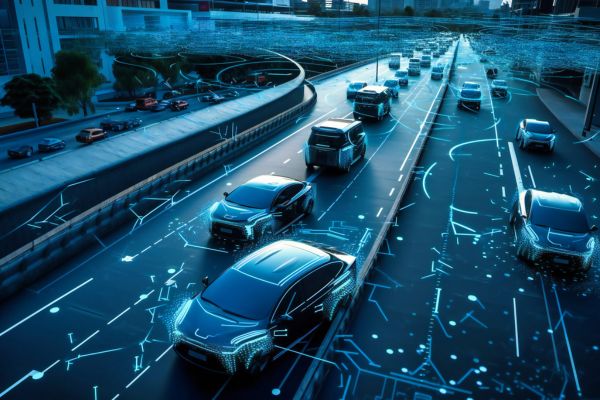
While the benefits of telematics as a technology are well understood across industry sectors, challenges still exist, notwithstanding rapid strides that have been made over the last few years, affirms Suraj Nair, Director – Technology and Center of Excellence Leader (IOT & Telematics), Quest Global. In this exclusive Volt-Full interview, Suraj Nair extensively shares his vital vantage with Niloy from The Volt Post on many aspects of the telematics market, including; challenges automotive OEMs are facing in 2024, the role of connected vehicles in promoting sustainability, the design of GHG protocol, the future of IoT with telematics and Quest Global’s growing trajectory. He also touches upon the trends, cyber-risks and the company vision to cater to data regulations determining a secure and seamless future, Edited Volt-Full Excerpts Below.
Opportunities and challenges that automotive OEMs are facing in 2024 while adopting IoT solutions for various markets and geographical areas.
Automotive OEMs are in an exciting space in 2024 as they redefine themselves as software and mobility companies, to grab the immense opportunities that software and digital offers in their space today.
Connected cars have enabled OEMs to realize the potential that software and digitization offers beyond traditional differentiators like engine power, build of vehicle body etc.
In fact, to handle the rapid explosion of software within the car, Automotive OEMs have realized the need to re-architect legacy in-car architectures for a software-defined future with compute capability (datacentre in the car), connectivity, cloud and AI being foundational.
Traditional OEMs that have held on to existing distributed architectures over decades, have realized the need to shed the past, and embrace a software defined future.
What are some of the opportunities then ?
- Enabling new experiences with new vehicle features during the lifetime of a vehicle’s ownership by unlocking over-provisioned hardware and enabling updates via subscription services and OTA.
- Connected infotainment enables the vehicle to be a seamless extension of the vehicle owner’s digital lifestyle when it integrates with services served on various digital interfaces that the vehicle owner uses outside the vehicle.
- Connectivity in vehicles enables alternate continuous revenue streams for OEMs beyond the point of sale. A marketplace of innovative features and applications, available for customers on a subscription basis, enables the power of choice for the vehicle owner while also enabling revenue streams through subscription services.
- Urban Mobility solutions like ride-hailing, ridesharing etc. need a connected ecosystem – with tracking location of vehicle being a fundamental requirement to trigger other use cases.
- R&D teams of OEMs today leverage insights driven from data captured from vehicles to constantly review and evolve vehicle designs. This enables OEMs to continue to compete in a highly competitive market by producing newer models that are more efficient and sustainable.
- OEMs can help improve city infrastructure by sharing information on the state of road conditions (broken roads, slippery conditions etc), traffic conditions, accidents etc.
- Revenue from data monetization opportunities where OEMs can build and offer data products in the data marketplace based on data that is collected.

And, then there continue to be challenges.
- Cybersecurity risks – Connectivity opens up threat vectors like hacking by rogue players if surfaces (ports etc both on devices and on telematics platforms) are not properly secured. There is a constant need to implement and improve security guardrails to be at par with evolving threats in the market.
- Privacy concerns – While use cases like usage-based insurance are gaining interest, this would require vehicles to share information to a platform that can determine driving behaviour. For privacy conscious users, opting for a privacy mode in the vehicle, will result in data not being available for inferring driving behaviour which is fundamental to usage-based insurance (UBI).
- Technical complexity in architecting connected platforms and handling global deployments – While the trend is towards building global connected platforms, there is a lot of customization required to conform to expectations in regions of deployment across multiple dimensions- consumer expectations, infrastructure constraints, compliance requirements and more. For example, connected navigation solutions in vehicles launched in the EU market will have to consider dynamic changes in the navigation feature set as vehicles cross open borders (for example, marking speed camera locations on navigation is illegal in France, but not so across borders).
Role of connected vehicles in promoting sustainability and reducing environmental impact?
Given that statistics have indicated that the transportation sector contributes significantly to overall carbon emissions, there has been intense pressure on the sector to reduce emission impact through regulations. Connectivity in vehicles enable data collection, which opens up opportunities to optimize emissions from vehicles.
- Preventive Maintenance based on vehicle data – Vehicle Health Reports, generated on analytics of vehicle telemetry data, enable early detection of anomalies that contribute to reduced fuel efficiency and increased vehicle emission.
- Driver Coaching – Analytics on vehicle telemetry (hard braking, sharp turning, sudden acceleration, idle engine etc) received during a trip can be used to understand driving behaviour. Drivers can be incentivized to improve driving practices using gamification-based applications. Navigation applications can also provide real-time feedback to the driver that help improve vehicle fuel efficiency and extend lifetime of mechanical parts.
- Multi-modal and micro-modal options in route – Intelligent Navigation systems can be designed to offer routes (based on the profile of the user planning the trip on the navigation system) that incorporate multi and micro modal means of transport (rent a e-bike, use public bus/train, walk etc) to the destination. This can be achieved by integrating the backend platform with services from various third-party service players and urban transportation systems.
- Encourage adoption of Electric Vehicles – Eliminate cognitive overhead and need to proactively remember the state of charge of vehicles by integrating with various end user devices outside the vehicle to provide relevant information regularly. Intelligent Navigation systems can suggest routes based on the vehicle’s current state of charge, incorporating access to charging points enroute if necessary. These routes are optimized post comprehensive analytics taking into consideration current state of charge, distance to destination, terrain conditions enroute, gradient of terrain enroute, ambient temperature, traffic etc.
- Intelligent Charging – Connected EVs can be configured to charge in multiple ways with the end objective of optimizing grid consumption. (1) Vehicles can be configured to charge during those times of the day when the stress on the grid is low. (2) Interestingly, vehicles can also be configured to charge only during those times of the day, when the energy on the grid is being sourced from renewable sources and not fossil sources. This reduces the need to burn more fossil fuel to meet peak conditions caused by EVs charging on the grid.
- Vehicles as source of energy to the grid – Connected EVs can be configured to discharge energy back to the grid (Vehicle to Grid) during peak load conditions. EVs thus serve as one of many distributed energy sources in the grid.
Alike a ‘spark start’ by a few companies, can every company be confident in sharing their Product Carbon Footprint (PCF) data?
This is an interesting question. With the negative effects of climate change becoming obvious, it is necessary that carbon emissions across sectors be monitored, accounted for and controlled. This is something that is expected of enterprises as there is increasing regulatory pressure and demand from consumers to understand the carbon footprint of the products they manufacture.
While this is a growing trend, and the focus today is primarily on the large enterprises, the design of the GHG protocol tends to enforce the need for the smaller players (who are suppliers to the larger product companies) to calculate and publish their footprint too.
While the pressure is on, there may still be reluctance on the part of companies because of a few reasons
- Supply chains are complex and extend multiple tiers involving small players. It may not be currently possible to audit correctness of emission data being declared by such suppliers – some of whom may not be organized and hence may lack standardized processes to monitor emissions.
- Intellectual Property protection – Organizations achieve an edge over their competition in the market by innovating in production processes, supply chain operations and supplier partnerships. The concern that some of this information may need to be shared as part of emission reporting is a damper.
- Lack of expertise – Given that this is a recent ask, lack of expertise in the industry on accurately capturing an organization’s carbon footprint may deter the process. Companies may fear liability issues and damage to reputation if data reported is found to be inaccurate at a later point of time.
- Brand impact – With the current generation of consumers (Millennials and Gen-Z) being more environment conscious than ever before, companies fear damage to brand image and product sales if their emission numbers are found to be high.
However, there are some companies who view this as an opportunity There are large organizations who have made significant investments in their sustainability processes over the last few years, being tuned in to global trends and to how large enterprises are aligning. These companies have also been upfront in publishing strides in their sustainable business practices as part of their Quarterly/Annual reports.
(In some cases, though, this may be forced as a result of investor and consumer pressure, who demand more transparency.) Such companies can see sharing this data as an opportunity to differentiate and attract environmentally conscious consumers away from those businesses that don’t.
Do you think telematics technology still faces challenges like limited network coverage, slow data transmission speeds, and high costs of implementation?
While the benefits of telematics as a technology is well understood across industry sectors, challenges still exist, notwithstanding rapid strides that have been made over the last few years.
- While the challenge of limited mobile network coverage in remote and rural areas still persists, organizations are looking at harnessing satellite technology for some specific use cases like emergency call (as available in the iPhone 14 onwards) for collision detection and SoS features. The proliferation of low-earth-orbit (LEO) satellites for internet connectivity and competition is this domain, is expected to bring down the cost of satellite-based communication in the near future.
- Countries are served by specific telecom service providers and they have their own SLAs. Things become complex in the domain of international logistics or global fleet operations, when vehicles transit across boundaries – as calls/tracking costs may escalate on roaming operations. Connected vehicle OEMs generally contract SLA agreements with telecom service aggregators like KDDI for example, that provide aggregator platforms that seamlessly handle service transitions across telecom service providers.
- Urban areas continue to have a significant impact on cell signals because of density of high-rise buildings causing interference, network congestion due to high population density resulting in slow data speeds and more strain on cell towers. Proliferation of 5G is expected to improve cell signal strength and reliability because of higher capacity (higher frequency bands), small cells densely deployed in high population areas and faster speeds as a result of incorporating technologies like beamforming and massive MIMO.
- Cost of implementation continues to be high. While after-market solutions involving a telematics device connected to the OBDII port continue to be in existence, these are being rapidly replaced by in-vehicle telematics solutions – especially in the consumer car market.
- Cybersecurity and Data concerns – Cybersecurity concerns continue to be primary in connected vehicle solutions and a significant amount of effort and cost is expended on ensuring end to end security across device, data, and connectivity. Cybersecurity is required to be continuously separated as new cyber threats emanate every other day and solutions need to keep up to or even ahead to prevent disastrous security breaches. Systems need to be implemented to ensure data is not compromised and local data compliance expectations for regulations like GDPR or CCPA etc. are adhered to.
Perspectives on the future of IoT and telematics, and how Quest Global is shaping the industry’s trajectory.
We continue to see increasing adoption of IoT in digital transformation initiatives of our customers across consumer, industrial, enterprise, medical and commercial segments. We see this trend continuing – driven by technology advancements enabling hardware miniaturization with growing compute, dropping hardware costs, ubiquitous connectivity and advancements in cloud computing services from the hyper-scalars.
The widespread adoption of 5G (now happening in spurts and needing to pick up momentum across regions and industries) and integration of AI and ML to churn enormous amounts of data to deliver knowledge, wisdom and action – will continue to be game changing. The recent global focus on sustainability with regulations mandating enterprises to furnish carbon emission footprint reports will also push IoT adoption.
Enterprises are expected to adopt IoT to both, (a) enable use cases that help reduce emissions (vehicle health analytics, route optimization etc.) and also (b)enable emission monitoring using sensors and IoT devices to enable accurate reporting to regulators.
Not withstanding the euphoria around the opportunities that IoT and Telematics solutions present, cybersecurity continues to be a core concern, given that a large amount of data (sometimes personal and sensitive) will be collected thanks to sensor deployments.
Another concern would be around device security, as the risk of cyberattacks continue to increase, especially in segments like automotive, medical and smart cities. Protecting such assets will be a continuous challenge as rogue players continue to experiment with new methods of intruding into systems and gaining control over devices and data.
At Quest Global, we are in the business of enabling engineering and business transformation for our customers. Today, we work across eight major industry segments (Energy, Aerospace & Defence, Automotive, Healthcare, Semi-conductors, Hi-Tech, Rail and Communications) and given the depth of our relationship with our customers and the markets that they operate in, we typically have exceptionally good understanding of transformational trends upfront.
Our presence across these verticals helps us identify use cases and technologies that are common, and also help us recommend unique use cases that could be cross seeded across segments.
From a technology realization perspective, we work across all technology segments that are relevant to realizing end-to-end IoT solutions – right from embedded software, hardware design, connectivity technologies, cloud platform engineering, data platform engineering, AI & ML and end device delivery (wearables, mobile devices etc.)
Recent trends and developments in the automotive industry and how these trends shaping the future of mobility.
Technological advancements in vehicle design, digitization, changing consumer preferences and focus on sustainable lifestyles have had a transformative impact on the automotive industry.
Connected vehicles are the norm across global markets, with intense competition among OEMs focused on innovating in software. Automotive OEMs today are becoming software companies, developing and managing their own cloud telematics platforms, so as to be able to own innovation in-house so as to be able to drive revenue from such services.
There has been a clear increase in Electric Vehicle adoption globally. Battery technology has also seen significant progress with high energy density batteries, faster charging and long driving ranges. Charging infrastructure is now ubiquitous in most countries in response to the demand due to increasing EV adoption.
There is a concern though that as more and more electric vehicles roll out of dealerships, the stress on an already loaded grid will increase, which will result in more fossil being burnt at energy production to meet the load requirements. Managed charging solutions enable environment conscious users to configure vehicles to charge only at non-peak times of the day or when the grid is sourcing energy from renewable sources. This is expected to reduce load on the grid and reliance on more fossil sources for energy production.
Autonomous Vehicle technology has seen significant progress with “Level 3” and “Level 4” autonomy being experimented with in constrained environments. Progress in AI technology with advanced sensors like RADAR, LIDAR and powerful cameras along with powerful edge compute hardware and software SDKs from SoC companies have enabled AI workloads to execute within the car and take real real-time decisions necessary in autonomous driving scenarios.
Circular economy is an interesting concept with vehicle components being tracked through their life cycle for end-of-life handling and also to check fitment for new productions. Battery Passports is one such concept, which is basically a digital system that stores relevant battery data along the entire battery lifecycle to enable circular lifecycle management.
The concept of Shared Mobility enables ride hailing and ride sharing services that are aimed at offering alternatives to vehicle ownership. Telematics Platforms are fundamental to this concept. In urban areas, MaaS offers a more sustainable, convenient, and cost-effective solution to transportation by combine multi-modal transport options for people’s mobility needs.
Quest Global’s initiative to comply with evolving data regulations and industry standards.
Quest Global has comprehensive Information Security policies with respect to data regulations of all the countries that Quest Global operates from. These policies cover all the necessary requirements for all our employees as well as vendors that we engage with.
Data security and privacy are important in the age of advanced telematics. Unauthorized access and data breaches become more likely when telematics systems gather and handle enormous volumes of data in modern automotive. What Quest Global’s move towards a secure and seamless future.
Quest Global has comprehensive data security and data privacy policies as part of the Quality and Information Security Management System. Quest Global is certified for ISO27001 and TiSAX wherever applicable.
While collaborating with our customers on building solutions, we ensure adherence to the customer’s expectation of data security and privacy.
Quest Global has been architecting and implementing solutions for our customers where we consider security as a fundamental concern when building connected solutions and ensure security concerns are addressed across multiple dimensions of the solution – device, network, data, application, and people. Quest Global uses a combination of practices, tools, and processes to ensure adherence to security requirements.




